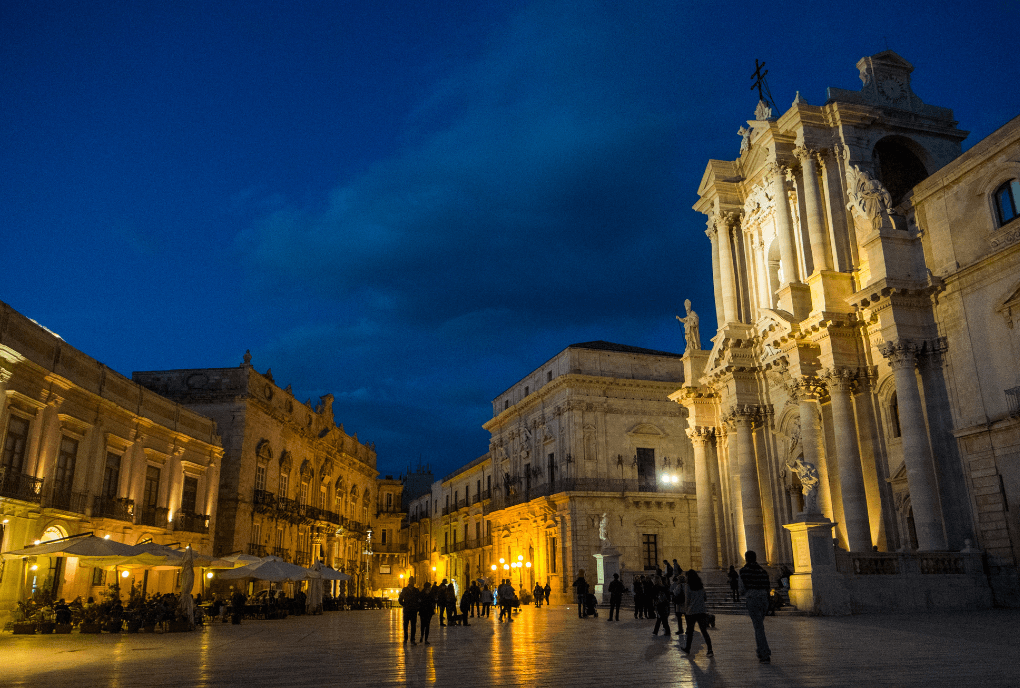
Cathedral Square in Syracuse, a treasure trove of treasures
So beautiful that you are moved, magical at any time of the day. The Baroque square in the city of Syracuse is one of the most beautiful in Italy.
In the heart of the island of Ortigia lies one of the largest and most sensational squares in Italy. What we are about to describe to you is the fascinating Cathedral Square in Syracuse, a triumph of Baroque architecture and one of the mandatory stops during if you are in the area. Along its perimeter are concentrated all the main monuments of the city, such as churches and elegant noble palaces.
Among its many treasures, the most valuable is surely the Cathedral. With its sheer size and opulent structure, it is certainly the first spot where the visitor’s eye lingers spellbound. Recognizable from afar by its mighty Greek columns, it is a first-rate architectural masterpiece as well as a key place of worship throughout history. To date, it is dedicated to Catholic worship but throughout its history has been a Greek temple and mosque. A succession that reflects the entire city and Sicily in general, which has always been a land of cultural entanglements.
The Cathedral of Syracuse dominates the Cathedral Square with its elaborate 18th-century facade, the result of interventions over time. It is not the only attraction to visit, however, as the Cathedral Square is a little treasure chest waiting to be discovered.
Not only the cathedral: the other well-known buildings
Prominent among the many historic buildings facing the square is the Palazzo Beneventano del Bosco, a well-known Baroque building that housed Admiral Nelson at the time of the Napoleonic battles. The Town Hall and Palazzo Borgia Impellizzeri dominate the square with their beauty, along with places of worship in addition to the cathedral, such as the Church of Santa Lucia alla Badia, inside which it is possible to admire a painting by Caravaggio.
The center of daily life for Syracusans and tourists alike, Cathedral Square is also a gathering place that over time has been endowed with small bars and restaurants where, even if only sitting comfortably at a small table, one can indulge in a moment’s respite from the local architectural beauty.
A bit of history
The Cathedral is truly a treasure chest of many treasures. Its elegant Baroque facade hides inside one of the most famous and best-preserved Doric monuments in Sicily: the Temple of Athena.
The Greek temple was commissioned by the tyrant of Syracuse Gelon in 480 BC to thank the goddess of wisdom for his great victory at Imera against the Carthaginians. Almost all the columns of the Peristyle and parts of the walls of the original cell can still be seen. In the 6th century AD, the walls were incorporated into the Byzantine church that overlapped the original temple structure. The Byzantines erected solid walls in the space between the columns and opened eight arches on the ancient cell wall, thus transforming the temple into a three-aisled Christian basilica that was consecrated to the Virgin Mary.
Probably in the 9th century, under Arab rule, it was used as a mosque, while two centuries later it returned to being a Catholic church. During this period a new facade was built and the walls of the nave were raised in order to open new windows to better illuminate the interior.
Of particular note is the 15th-century polychrome marble pavement, which houses the coat of arms of the city of Syracuse in the center. In the late 1600s there was an earthquake that destroyed the Norman facade and bell tower, which was never rebuilt. The restoration that followed to reestablish the building was an opportunity to embellish the church internally and build a new façade on the outside, made in the early 18th century, which resembles a theatrical backdrop on the original Byzantine layout.
When to visit?
The cathedral is always open to visitors, with a slight change in hours extending to 7 p.m. in the summertime. For visitors from outside there is a 2 euro ticket fee, reduced to 1 euro for pilgrims or school groups.
Ready to be captivated by the beauty of the Cathedral?
Giulia Nari





